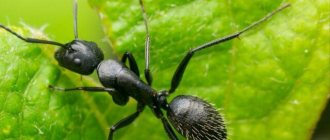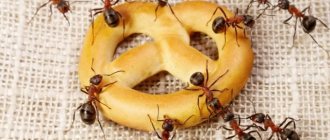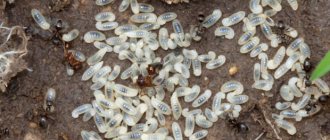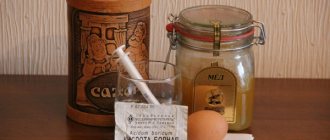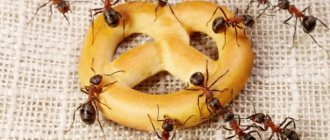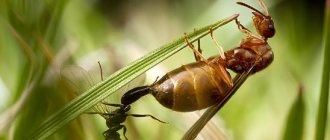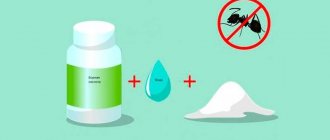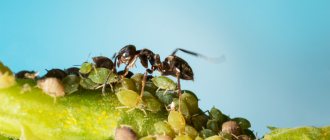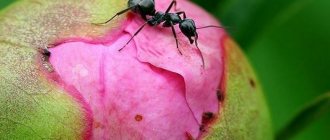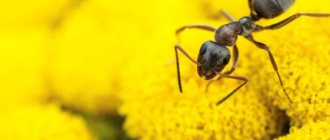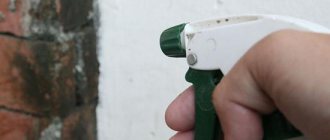Causes and consequences of ant attacks on currants
Currants give off a pleasant aroma that attracts almost all types of ants: meadow ants, black garden ants, red forest ants and the like.
Causes
The main reason why ants attack plants is aphids. Aphids have a partnership with ants, where the latter protect the former by fighting insects such as lacewings, ladybugs, ground beetles and others.
And the aphids, in turn, provide the ants with a constant supply of honeydew - this is the sweetish excess liquid secreted by them. Ants consider this liquid a very valuable resource. As a rule, ants build their anthill close to some vegetation.
Consequences
First of all, insects eat the roots of plants and fruit trees during the construction of an anthill, and then:
- They reduce the fruiting of plants by destroying the inflorescence by eating the nectar of flowers.
- During hot weather they eat the upper parts of young shoots of bushes.
- Insects colonize aphids on shrubs and trees.
- In order to get the necessary nutrients, ants attack red currants and other plants and drink all their liquid, which leads to the fact that the plant may not survive the winter.
Beneficial effect on shrubs
Many people know from school that anthills should not be broken. This comes from the fact that even ants that are not loved by everyone can also bring benefits, namely:
- Destroy caterpillars and harmful insects.
- During the construction of their anthill, they loosen the top layer of soil and also fertilize it with potassium, nitrogen and humus.
- They collect corpses throughout the garden and speed up the process of their decomposition.
How to get rid of ants in the garden
To protect garden trees from ants and prevent aphids from appearing on the leaves, the trunks are wrapped with adhesive tape to catch flies before branching. Insects will stick to this barrier.
The trunks of garden trees can be wrapped in foil; its slippery surface will prevent ants from climbing up to the crown of the tree.
While some folk remedies for ants may fail, chemical insecticides destroy ants outright. Nowadays, many anti-ant preparations are sold in the form of powder, gel, granules or emulsion for dilution in water - these are Antiant, Anteater, Ant, Muratox, Thunder and others.
All chemicals must be used with precautions
Bottom line
- Ants destroy currant inflorescences, roots, young shoots of bushes, and spread aphids on branches and buds.
- You can save currants from ants in a couple of days using chemicals; it is recommended to use products based on diazinon.
- There are several biological methods of controlling insects; such measures do not harm the plant, but act slowly.
- To prevent the ants from returning, you need to fight aphids; for this you can use folk remedies.
Using professional products
Before you start using professional means to get rid of insects, you must first try to get rid of ants on currants using folk remedies, since specialized preparations also kill beneficial insects, which, in turn, get rid of other pests.
Clean house
Clean Home is an inexpensive gel that works well against pests that will attack not only at home, but also in the garden.
You can apply the gel either on ant paths, or first apply it in a dotted manner on paper, and then place it in a place where ants accumulate. The poison will begin to act in 24-36 hours.
Summer resident
The Dachnik preparation is based on fir oil, which repels garden ants and other pests.
The advantages of this drug include:
- Easy to prepare.
- Economical.
- Efficiency.
- Wide range of applicability.
How to use:
- Shake and open.
- Pour 5 ml of the drug into an 8-liter bucket filled with water and mix with a stick.
- After removing the top layer of soil from the anthill, water it with 2-3 liters of solution.
The protection will be valid for six months. In addition to the anthill, the product can also be used on beds and paths in the proportion of 5 liters per 1 cubic meter.
Grom-2
Grom-2 is a granule designed to get rid of pests such as soil flies and garden ants. For the drug to start working, you just need to spread it over the surface of the anthill so that the insects can come into contact with it. The drug is valid for 2-3 months. It must be applied with rubber gloves; although it is not harmful to plants and soil, the same cannot be said about human skin.
Phenaxin
This product is intended not only for treating premises, but also for vegetable gardens. It causes insects to curl up and not die immediately. First, on their paws, they carry the poison to their anthill, where they infect their relatives with it.
Sprinkle a thin layer of powder onto the ant paths. If necessary, you can apply the powder again after a month.
Muratox
How to use:
- Dilute 1-2 ml of the drug in 10 liters of water.
- Dig up the anthill and water it with freshly diluted solution.
- Sprinkle with earth.
Or you can lure the insects with some sweetness and spray them with the solution. Valid for 1 month. Muratox is dangerous for fish, so you should avoid possible contact of the solution with the water.
Ant-eater
One ampoule of anteater is diluted in 10 liters of water, and then you will need to water the anthill with the resulting solution. The drug will begin to act in 2-3 weeks.
Pyrethrum
Pyrethrum is an insect repellent powder that is almost completely natural and very effective.
To prepare the infusion you need:
- Mix 300 grams of powder with 1 liter of water and let the solution brew for 12 hours.
- Do the same, but with 4-6 liters of water.
- Then mix solutions 1 and 2.
Antiant
This product has a filler that attracts ants, and it also does not have an unpleasant odor. It is necessary to evenly distribute the product along ant paths and their clusters. The ants will disappear in 2 days. The duration of action of the solution is almost 50 days.
Chemicals
Muratox
Dilute 1 gram of muratox with 10 liters of water and pour the solution into the anthill, and after 3 days the pests will disappear.
Muratsid
Also dilute 1 gram of the product with 10 liters of water and pour it into the anthill. The pests will disappear in 1 day.
Biorin
Dilute 2.5 ml of the drug with 1 liter of water and spray the anthill with the resulting solution. All ants will stop appearing after 1 day.
Sinuzan
Dilute 1 liter of water with 2.5 ml of product and spray the ant paths and the anthill itself.
Mechanical means of control
- Currant pruning, sanitary and seasonal (the first is carried out at any time of the year, as soon as diseased branches and leaves appear, the pruning is burned; the second - in spring and autumn, old, weakened shoots are removed and burned).
- Hot shower (in the spring, before the buds open, currant bushes are watered generously with water at 80 degrees to kill insects that have overwintered on the plants).
- Digging the tree trunk circle (destruction of anthills, pests overwintering in the soil; this cannot be done often, as it damages the surface roots of the currant).
- Weed control (weeding or pruning; weeds contribute to the spread of aphids).
According to the experience of gardeners, ants leave on their own if you move their anthill to the edge of the berry garden two or three times.
You can also wash off the aphids with high-pressure water and suppress them manually (with gloves), but this is labor-intensive and the effect is short-lived.
Prevention of occurrence
To ensure that aphids almost never appear, you need to constantly monitor the health of the plants.
You also need:
- Clear the garden of leaves.
- Mow down the weeds.
- Cut out root shoots and tops on which eggs can overwinter.
- Destroy or contain anthills in spring and summer.
Traditional methods - what can you spray with during flowering and save the plant?
Environmentally friendly: do not kill ladybugs and bees. The following methods are good against ants:
- Scald with boiling water (first stir up the anthills; repeat the procedure several times; do not use near currants, so as not to destroy their roots).
- Water the anthills with a solution of kerosene and diesel fuel (measure 10 tablespoons of each substance, dilute in water (10 l)), place it near a container with oleic acid, the smell of which ants are “afraid of.”
- Place poisoned baits for insects (containers with a mixture of equal parts of boric acid and honey (sugar, jam or yeast) under the plants: such “feeders” are safe for people and animals; boric acid has a nerve-paralytic effect on ants; yeast spoils their food supplies , “intoxicate” the insects, and they stop obtaining food for their queens and larvae).
- Sprinkle anthills and bushes with lime, wood ash, tobacco dust, red pepper or cinnamon.
Currants can be sprayed against aphids with herbal decoctions and infusions:
- Garlic - half a kilogram of raw material is infused in five liters of water at room temperature for one day; sprinkle with strained garlic water.
- Tomato leaves - chop fresh tops (4 kg) and dry tops (2 kg), boil in water (10 l) for half an hour, cool, strain; store in a cool place, apply by diluting the decoction in a ratio of 1:5.
- Wormwood and ash - mix 500 g of herb, 5 liters of water and a glass of ash, leave for 5 hours; Before use, dilute with water 1:2.
- Also celandine, potato tops, dandelion and onion; mustard is also suitable for these purposes, but it is a strong allergen.
Aphids are also eliminated by fumigating bushes with celandine smoke and treating them with laundry soap.
Folk remedies against ants
Ants have two disadvantages: they do not know how to overcome water obstacles and move away from objects with sharp edges.
Experienced gardeners create a water barrier using halves of tires around tree trunks. Cut them into two halves lengthwise and crosswise in one place. They dig in, leaving 3-5 cm of the tire above the ground.
The cross-section is sealed and water is poured in, possibly with kerosene, a decoction of tops and other ingredients. The ants will not get onto the tree, which means they will lose food and leave.
Around the tree trunk at a height of 30-40 cm, a skirt is made of foil with sharp edges sticking out. Ants are afraid of sharp objects. Crawling to the sharp edge, they fall down and do not reach the aphid colonies on garden crops.
Of course, these methods are not a panacea, but they will help reduce the number of anthills in the garden. At the same time they fight against aphids (required). The aphids will go away, and the ants will go away.
Garden and household ants are antagonists of the forest brothers. Find an ant heap in the forest and collect the top layer of soil with adult ants in a thick bag, and at home pour them onto the garden anthill. The garden ants will lose the war and leave the site, while the forest ants themselves will try to return to the forest in 1-2 weeks (at least, outside the dacha).
Among other folk remedies, gardeners and gardeners recommend various herbal decoctions and compositions. One of the gardeners suggested an interesting technique. To a 10 liter bucket of water add 1 liter of table vinegar and 2 cups of shampoo and vegetable oil.
Make a deeper hole in the center of the anthill with a stake and blow the well-mixed mixture into the hole through a sprayer. Cover the entire anthill with black film or other opaque material.
Neighbors at the dacha collected torn garlic arrows, ground them to enhance the smell, and steeped some of them in water. Then several of the torn up anthills were filled with solution, and several were thrown with crushed arrows. The ants have left, but how far is unknown. Maybe they just moved to a new place in the garden, or maybe they left the site.
Having studied the habits of ants and the structure of their colonies, it is not difficult to defeat the “enemy” and get rid of ants. But to prevent them from returning, preventive measures must be taken constantly. They come from everywhere, and it is impossible to get rid of ants forever with one-time techniques.
Symbiosis of ants and aphids
Honeydew, which is secreted by aphids during their life processes, is one of the favorite delicacies of ants, whose food mainly consists of carbohydrates and protein. Of course, ants, on occasion, will happily “snack” some other insect larva, a piece of fruit, seeds or plant juice, but honeydew is a very high-calorie and affordable food, and therefore very desirable for ants.
As you know, ants are very highly organized creatures that, in the process of evolution, acquired the ability to learn and teach. So, having discovered that aphids are capable of producing such a healthy and tasty product, the ants practically turned them into their “livestock”.
They not only know how to “milk” it, tickling its abdomen with their antennae and stimulating an increased release of honeydew, but also transport aphids to the youngest, juiciest and most tasty parts of plants, and, if necessary, protect their “herds” from their natural predators (ladybugs, hoverflies, lacewings, etc.) and even build special protected shelters for them or keep them in their anthills.
Moreover, in addition to the fact that ants “breed” aphids, they themselves can actively damage cultivated plants, feasting on delicate buds, flowers and even roots, berries and vegetables. In addition, ants, in the process of their life activity, sharply acidify the soil around the anthill, and with their underground passages they cause damage to lawns, flower beds, beds, and alpine hills.
As you can see, despite the fact that ants can bring some benefit to a summer cottage - for example, by eating harmful caterpillars with larvae and taking part in the structuring and aeration of the soil - in general, they do much more harm to the summer resident and cultivated plants. And coping with such a numerous, active and omnipresent “enemy” is very, very difficult.
Ants: benefit or harm
Benefit
Ants destroy harmful insects by eating their larvae. By establishing their settlements in the fertile layer, they help plants receive more air, which, in turn, grow better and produce crops. Also, nutrition is better supplied to the roots in such soil, which naturally affects the quality and quantity of the harvest.
The most dangerous thing is that when ants appear on the site, they bring with them their “pets” - aphids. She feeds on plant sap. If you do not react in a timely manner, this can lead to withering and then to the death of the plantings.
What to do if you are bitten by an ant
And finally, let’s talk about what to do if, during a difficult struggle, several small goosebumps feel free to “nip” your hand or another part of the body. In temperate latitudes, an ant bite is not dangerous, but can be quite painful. Humans are usually bitten by warrior ants with large heads and powerful jaws.
A slight itching caused by a single bite goes away after a few hours and does not pose a danger to humans. It is much worse if an allergic reaction develops, the signs of which are the following symptoms:
- the appearance of swelling, blisters, itching;
- extensive redness of the skin, accompanied by pain;
- nausea, shortness of breath, headache, loss of consciousness.
The bite of one soldier ant is not scary for residents of the middle zone
Treatment for ant bites is as follows:
- wipe the bite site with a medicine containing alcohol;
- make a baking soda compress to relieve itching;
- relieve swelling that occurs after several bites using a compress of steamed birch leaves or raw potato pulp;
- take antihistamines;
- In case of severe damage, consult a doctor.
As you can see, it is quite possible to completely get rid of ants. Do this without any regret, because real pests settle on your site, which, unlike their forest counterparts, are not beneficial insects, but only cause harm to your plantings and food supplies.
What to do if you are bitten by an ant
And finally, let’s talk about what to do if, during a difficult struggle, several small goosebumps feel free to “nip” your hand or another part of the body.
A slight itching caused by a single bite goes away after a few hours and does not pose a danger to humans.
It is much worse if an allergic reaction develops, the signs of which are the following symptoms:
- the appearance of swelling, blisters, itching;
- extensive redness of the skin, accompanied by pain;
- nausea, shortness of breath, headache, loss of consciousness.
Treatment for ant bites is as follows:
- wipe the bite site with a medicine containing alcohol;
- make a baking soda compress to relieve itching;
- relieve swelling that occurs after several bites using a compress of steamed birch leaves or raw potato pulp;
- take antihistamines;
- In case of severe damage, consult a doctor.
As you can see, it is quite possible to completely get rid of ants. Do this without any regret, because real pests settle on your site, which, unlike their forest counterparts, are not beneficial insects, but only cause harm to your plantings and food supplies.
Most Read Reviews
Vermicompost for cucumber Grapes Isabella Grapes Muscat Grapes delight Gooseberry pests Pear early ripening Yellow cherries Seedlings of cucumbers turn yellow How to grow plums How to pollinate tomatoes How to water peppers How to plant a pear How to protect strawberries Calcium nitrate Strawberry Marmalade Strawberry Mashenka Strawberry Roxana Strawberry albion When strawberries bear fruit Raspberry hussar M Ulching cucumbers Mulching of tomatoes crumble berries why the tomatoes are withering why cucumbers disappear why the plum dries why the tomatoes are blackened by vaccination of grapes. Reproduction of lemon. Propagation of the rust of rust on cucumbers mesh for cucumbers. How much blooming lines of gooseberry varieties of sessions of the varieties honey than feed gooseberries than useful grapes black raspberries
Water the bushes with boiling water to remove ants and aphids
| i2.wp.com ” src=”https://qlumba.com/wp-content/uploads/2019/10/fmg5dafe74364b409.jpg” alt=”table_pic_” w /> | Reasons for appearance |
1. The main reason for the appearance of ants is aphids.
2. This is caused by the fact that aphids secrete a special juice, which is a favorite treat of ants.
3. They carry aphids to obtain more of this product, so they often set up their anthills near currants
medmafia.ru ” src=”https://qlumba.com/wp-content/uploads/2019/10/fmg5dafe7470f9a60.jpg” alt=”table_pic_” w />
Folk methods of disposal
1. Garlic infusion. Take a large head of garlic, pour boiling water over it, and leave to steep for 4 days. Water the anthill.
2. Trichopolum solution. Dissolve 1 tablet in 1 liter of water. Use the solution to spray the bushes. It is recommended to carry out work in the evenings so that sunlight does not leave burns on the leaves.
3. Tobacco infusion. Take 200 grams of tobacco, 5 tablespoons of red pepper, add 10 liters of water and leave for 24 hours. Suitable for spraying bushes, soil, anthills.
4. Potassium permanganate solution. Dissolve 3-5 g of potassium permanganate in 10 liters of water, add a grated piece of laundry soap, mix, spray the bushes twice every day, morning and evening.
5. Coca-Cola. It will help get rid of both aphids and ants. It is enough to spray the bushes with it and fill the anthill - the acid contained in the drink will kill the pests.
6. Celandine. The grass has a lethal effect on pests. You need to prepare a decoction from it: take 3 kg, add 10 liters of water, leave for a day. Treat the anthill and bushes
Chemical sprays
1. Chemicals should be used only if traditional methods of control have failed.
2. The most effective against ants are those made on the basis of diazinon.
3. Such drugs, entering the body of ants, first cause spasms, then kill them within 3-4 days.
4
It is important to use chemicals strictly according to the instructions so as not to harm the plants.
5. It is best to use “Ant”, “Thunder-2”, “Anteater”, “Muracid”
zemeljka.ru ” src=”https://qlumba.com/wp-content/uploads/2019/10/fmg5dafe7484f16e5.jpg” alt=”table_pic_” w />
Prevention of occurrence
1. Whiten the trunk of a bush in spring and autumn.
2. Spray the shoots in early spring with folk remedies or insecticides until the buds appear.
3. Properly care for currants, avoiding excessive siltation of the soil during watering and applying excessive amounts of fertilizers that attract pests.
4. Pruning regularly, removing weeds and digging up the soil in a timely manner.
5. Water the bushes with hot water until buds appear
Herbal decoctions
Some infusions need to be kept for days. If you don’t have time to wait, you can make insecticidal decoctions from plants. The following wild and garden crops are used for them:
Tobacco
For the decoction you will need:
- 300 g dry leaves, ground into flour,
- 10 liters of water.
The raw materials are poured with boiling water and boiled in a water bath for 15-20 minutes. After cooling, filter, add 30 g of soap and start spraying.
The decoction is prepared at the rate of 100 g of pepper (fresh) per 1 liter of water.
Boil for 60 minutes.
Strain before spraying.
Pyrethrum officinalis
At 4 tbsp. spoons of dried flowers need 1 liter of boiling water. Cook over low heat for 15 minutes. The resulting concentrate must be filtered and brought to 10 liters.
Wormwood
A decoction of wormwood is prepared in the same way as from pyrethrum.
In the old days, our ancestors tied wormwood into bunches and covered currant bushes with them to prevent aphids and other pests.
A. A. Popova “Medicinal Plants”, ed. "Spike", 1988
Photo 4. Bunches of wormwood can be surrounded by currant bushes so that ants and aphids do not penetrate the shoots.
Effective, harmless methods for exterminating pests
Protecting your own crop should begin even before aphids and ants have time to spread. You need to start with the appearance of the first buds on the bush. They need to be examined carefully. If red or black currants have buds that are round in shape and somewhat larger in size, then aphids will soon appear in such bushes.
What to do to prevent aphids from spreading:
- Scald the bush with boiling water. This will kill the aphid eggs.
- Use a special insecticide for spraying. Karbofos, Rovikurt, Inta-Vir, Commander Maxi, Aktara and many other effective aphid preparations are highly effective. Modern products have a contact and complex effect, are not sensitive to moisture and have a wide spectrum of action. The cost of insecticides depends on the volume of the substance, the active ingredient and the manufacturer.
Ant control agents
Also in this case, you can get rid of aphids using folk remedies. To do this, you need to prepare a special solution and spray the plants. How to treat currants against aphid invasion:
- Grate the third part of the soap bar on a coarse grater and dissolve in 1 liter of warm water. It is optimal to use tar soap, which has a specific smell.
- Pass a glass of garlic cloves through a press, add a liter of water and leave for at least 4 days.
- Pour boiling water over 300 g of wormwood and leave for 3 days.
If the infection is not critical and only a small part of the kidneys is affected, then they can be removed mechanically.
The garden is a real paradise for ants, as they really love fruit trees and shrubs. Many gardeners simply have to resort to the measures that will be described below in order to save their harvest.
Ants in the garden can cause a lot of trouble. A colony of ants, including a queen whose sole responsibility is to lay eggs, can number hundreds of thousands of inhabitants. During the mating season, males and females have wings. The most numerous group are infertile females - workers. They build an anthill, protect it from intruders, take care of the offspring, and collect food for the whole family.
Now, it is important to note that in order to get rid of ants, you also need to eliminate aphids. • eat the roots of bushes, which leads to the death of the plant;
• eat the roots of bushes, which leads to the death of the plant;
• weaken the plant by infesting it with aphids and other pests that secrete honeydew;
• ants destroy currant flowers in search of nectar;
• ants in the garden during drought gnaw the young tops of plants.
All these reasons force gardeners to resort to various methods, even chemicals. Let's look at ways to get rid of ants on currants that will not harm the plant.
First you need to conduct a thorough inspection of the currant bush for the presence of aphids. If a small number of pests are found, you can try to wash off the insects with strong water pressure. Large colonies of parasites are destroyed using the following methods:
- Make a soap solution of 3% concentration and spray the berry plant with it. As a result of such exposure, the insects will stick to each other and die.
- Place chopped potato leaves in a bucket and fill them with water. Boil the solution, let it brew for several hours, strain and spray the berry.
- Peel and chop 200 grams of garlic. Infuse this product in 1 liter of warm water for 5-6 days and treat the currant bush.
- Use a 20% infusion of onion peels to combat aphids. The raw materials are poured with water, boiled and allowed to cool, after which the leaves of the crop are sprayed.
- Pests are afraid of wormwood, so use this potion to prepare decoctions and infusions.
In order for currant bushes to delight their owner with lush greenery and a rich harvest, proper and timely care of the bush is needed. Preventive procedures to prevent the appearance of diseases and pests are carried out in the fall. Caring for the crop involves removing the leaves and digging up the top layer of soil.
Agrotechnical measures
It may be a little unusual, but the number of colonies will decrease significantly if you kill the aphids. By the way, you don’t need to completely get rid of ants. New, more adapted pests will take their place. Aphids are the main “herd” that supplies “sweet milk” - honeydew to the voracious ant larvae.
The duration of maturation of the egg lasts 35 days, larvae - 7 days and pupae - 23 days. The lifespan of the larvae is 7 days and they enter the pupal stage, which stops eating.
These 7 days are the weakest link of the ant colony. They intensively supply food to the larvae. If you feed the larvae poisoned food during this period, the colony may not be revived.
So, to successfully remove ants from a site, you can perform the following procedures with large colonies:
Around the bushes, stepping back from the base, sprinkle ash thickly in a ring, you can mix it with lime. Lime is poisonous to ants.
Approximately in the middle of the trunk (40-80 cm), secure the fishing belts, treating them with insecticidal agents. To prevent ants from crawling over the barrier, lubricate the bole around the perimeter with special slow-drying glue (buy in a store).
They will not be able to overcome the adhesive barrier and will die along with their expensive burden. Hunting belts can also be used in the spring and summer (October and March), periodically replacing them with fresh ones.
Simultaneously with the hunting belts, for 8 days in a row, having dug up the ant colony to a depth of 3-8 cm, poison them in the evening (when the ants return home), pouring hot boiling water over the stirred up anthills, preferably a hot decoction of tomato tops (literally boiling).
You can dig it up and fill it with a mixture of ash and lime or ash and salt, or treat it with a mixture of ash and soda.
A good result is obtained if you fill the anthill with a mixture of water and kerosene (100-200 ml per 10 liters of water), digging it deeper.
Daily treatment for 8 days will destroy the larvae, some adult ants, possibly the “queen,” eggs, and pupae. Such treatments must be carried out systematically throughout the year, and the ants will leave the inhospitable dacha.
Ants love peace and settle in places where the soil is not subject to frequent turning, that is, it is not dug up, stones, weeds, etc. are not removed. If you are farming without digging, then surface treatment of the top 10 cm of soil is required. Look under a stone or cardboard or board that has been lying there for a long time and you will see a bunch of ant eggs with nannies right on the surface of the earth.
Plantings around the perimeter of the dacha, individual beds, under the canopy of trees and, especially, between berry bushes of tansy, parsley, mint, valerian, wormwood, lavender, and garlic can serve as preventive preventative measures against the colonization of ants.
How to fight garden ants with starch: recipe
Starch is an affordable and simple means to combat ants. This product can be used both in the garden and in the vegetable garden.
- If we are fighting pests at home, then we need to take starch and mix it with powdered sugar. We place the mixture near the places where insects walk and live. If an ant eats a treat, it will definitely die because the starch in its stomach will begin to swell.
- If you are working in a garden or vegetable garden, then first you need to calculate the place where the ants live, or at least the place where the maximum number of them gathers. We take starch, mix it with powdered sugar and also leave it for insects.
- It is not recommended to use starch without bait. The product itself has no value for animals, so without sweetness in the product, they may simply not try it.
How to get rid of it?
If there are too many ants in the garden, you will need to destroy some of the anthills. How to get rid of ants? What to do if they have become too prolific on the site? To do this, you need to resort to several methods:
- destroy anthills using folk remedies or chemicals;
- prevent insects from growing on trees by arranging trapping belts;
- place sweet poisoned baits on ant paths.
Ants very often choose black currant plants for aphid colonies.
How to get rid of insects if ants appear on currants? Saving currants from ants will not be easy. The fight against ants begins with getting rid of the anthill:
- near the anthill, scatter ground red or black pepper, tobacco, ash, dry mustard, cinnamon;
- along the circumference of the anthill, water the ground with vegetable oil, kerosene, gasoline, diesel fuel, chlorinated lime, urine, ammonia;
- bury the head of a herring in an anthill;
- Sprinkle salt or Karbofos powder along the main trampled paths of ants;
- sprinkle millet, corn flour, baking soda on top of the anthills;
- cover the anthill with tomato, parsley or wormwood leaves;
- water the anthills with boiling water and vinegar;
- pour a mixture of sugar and boric acid onto the anthill; instead of sugar, you can use jam or honey.
Experienced gardeners mix yeast with jam, leave the mixture for several hours and place it under the currants. The worker ants get drunk from this treat, stop feeding the young, and the colony dies.
In the spring, garlic is planted near a currant bush affected by aphids. Neither ants nor aphids can tolerate the smell of this plant. Planting garlic will rid the currants of both insects at once.
Many gardeners do it even simpler - they use chemical insecticides:
- Diazinon is a very potent drug, it contains a 60% Diazinon emulsion concentrate. Once in the pest's body, it causes paralysis and death. It can be sprayed on currant branches; it does not accumulate in plants.
- Anti-ant - consists of boric acid and bait, scattered near the anthill for the ants to eat. The effect will be noticeable within a week.
- Pyrethrum - contains a natural insecticide made from ground chamomile. Treat the anthill with the powder form, and the currant leaves with the water form.
Very effective and popular are ant gels such as Global, Rubit, Brownie, Raptor.
If ants have bred aphids on currants, then you need to think about how to save the currants from these pests. There are many tried and true ways to protect blackcurrants. For example, spray the branches:
- a solution of liquid soap or dishwashing detergent;
- infusion of garlic or onion (1:10);
- a decoction of yarrow, tansy, onion peel, wormwood, peppermint;
- infusion of potato leaves, tomato, chopped garlic, tobacco;
- a weak solution of potassium permanganate with the addition of liquid laundry soap;
- clean water and sprinkle them with ash.
A good result is obtained by fumigating a bare bush in early spring with dry wormwood branches sprinkled with 1 tbsp. l. dry garlic and 3 tbsp. l. pharmaceutical chamomile.
You can place picked wormwood and tomato shoots under the currants; their smell repels aphids. Adding soap to solutions not only improves its adhesion to leaves, but also creates an alkaline environment that aphids cannot tolerate.
Do not forget to thoroughly process the leaves on all sides, unfold the wrapped ones into lumps and rinse well in the prepared mixture. The treatment will need to be repeated 3-4 times until the aphids disappear completely.
Common Mistakes
Mistakes of those gardeners who decided to deal with aphids:
- they plant garlic thickly;
- After collecting garlic seeds, you must dry and check them, and then repeat the process before planting;
- infusions and decoctions are ineffective over large areas; in this case, you can use chemicals;
- After processing the trees, you still need to cut off the tops;
- If wounds are found on trees, you need to cover them with varnish and then spray it with copper-containing preparations. Otherwise, the tree may get sick.
It is very difficult to remove aphids and ants, but if you want to get results, then you don’t need to focus only on poisons. You need to constantly monitor your garden, every tree and plant. And only then can you get a good effect.
Fighting methods
To protect currants from insect pests, there are folk remedies, agricultural techniques, biological and chemical industrial poisons. Treating bushes with chemicals is effective, but the bush is affected (damage to foliage, retention of chemicals in plant tissues), the soil underneath it (accumulation), beneficial insects and other inhabitants of the garden are affected. Folk “herbal” recipes or sanitary pruning with the destruction of the affected growth do not provide a 100% guarantee, but they are environmentally friendly and allow you to obtain organic products.
With aphids
Aphid larvae appear in the spring with the onset of warmth from under the bark of the shoots, suck out the juices until the foliage stops growing (mid-summer), “grow” wings, and spread to other plants. There they continue to feed and reproduce at high speed; in the fall they again move from the foliage to the branches, under the bark of which they lay eggs. There they spend the winter and develop. Aphid larvae and eggs hidden in shoots and buds are destroyed by pruning and burning old branches. Against adult forms, attract natural enemies of aphids to your site - birds, ladybugs, lacewings, earwigs, hoverflies, use folk remedies or pesticides.
With ants
Gentle methods (scaring, eviction from the site) are effective if the ant colony is small. If it is large or if there are a lot of anthills in the berry garden, it is more advisable to destroy them: with the help of natural enemies (introducing competitors - red forest ants, attracting hedgehogs, birds), mechanical methods or chemicals. Killing insects on currants is ineffective. Start fighting ants by searching for their nests, which contain queens, larvae, and eggs. Find all the ant paths along which insects move in chains, place baits with poisoned food along their path, which they will eat themselves, take it to the anthills, or completely destroy them.
Signs of defeat
Types of insects that harm currants:
- The brown ant is a brown insect up to 9 mm in size. Builds dwellings that go deep into the ground. The above-ground part consists of plant residues. The pest eats flowers and currant berries, reducing productivity, and spreading aphids.
- The black garden ant is a representative of arthropods measuring 3-4 mm, with black outer integuments covered with short hairs. It builds a dwelling in the ground, creating numerous colonies, and breeds aphids.
- The sod ant is an insect up to 5 mm in size, yellowish-brown in color, that builds anthills underground. It feeds on currant berries.
Having noticed any type of pests on the site, you need to find their habitats. Anthills, established by insects in the garden, are holes in the ground with a characteristic sandy mound. By digging up an earthen mound with a shovel, you can find numerous passages; at the depths there are insect larvae and a queen. As the colony grows, the underground part of the dwelling grows in breadth and depth. Sometimes insects build anthills in the center of the currant root system.
Signs of a bush being damaged by a pest:
- stunting, lack of young growth;
- yellowing of foliage caused by malnutrition as a result of damage to the root system and increased soil acidity;
- buds and flowers with damaged petals;
- incompletely tied brushes;
- ugly berries;
- partially eaten berries.
The appearance of a sticky coating on the inside of currant leaves indicates that the bush is infested with aphids. At the same time as the pest, ants are found on the currants.
How to deal with the invasion?
There are many ways in which you can protect currants from aphids and ants:
- strong odors;
- traps and baits;
- barrier;
- professional products;
- destruction of the anthill;
- colony transfer;
- destruction of aphids.
Strong odors
Like most insects, ants do not like plants that emit a strong odor. Although they do not cause them any harm, insects still try to avoid plants such as:
- nasturtium;
- rosemary;
- marigold;
- catnip;
- dill;
- parsley;
- lavender;
- peppermint;
- Melissa;
- fennel and other aromatic herbs.
It would not be a bad idea to make a strong decoction of green plants and sprinkle it on the places where clusters of ants live. It will repel them, but the smell won't last long. This means that you will have to periodically spray the accumulation area.
Plant protectors
Ants do not like the pungent odors of some plants that are grown near the berry garden: valerian, tansy, anise, tomatoes, parsley, cloves, mint, lavender. The last two species (as well as thyme, oregano, sage, chistema) are the least preferable for “colored” currants, since by discouraging ants, they attract gall aphids to red currants.
You can protect against aphids by planting chives, garlic, mustard, marigolds, catnip, fennel, and coriander.
Corn cannot be planted near currants, since, on the contrary, they actively attract aphids.
It is also attracted to quinoa, but this weed, on the contrary, is recommended to be removed from under the bushes not immediately, but only after it has collected aphids on itself. After this, it is weeded out and burned.
Close plantings of calendula, nasturtium, cosmos, and dill will not only repel aphids, but will also attract beetles that destroy them.
Ants and aphids. Why do currant leaves curl?
If there are ants on currants or in a greenhouse with tomatoes, it means that aphids are parasitizing on the leaves. As already mentioned, this is due to the fact that pests love the juice that aphids produce. When aphids appear, the leaves begin to curl
For this reason, it is important to get rid of not only ants, but also parasites. If this is not done, other insects will soon settle next to the currants and the situation will repeat itself.
Read about measures to combat bud mite on currants here.
Where do ants bring aphids from and how to drive away pests
Ants take aphids from the inside of currant leaves. After this, they transfer the pests to other branches and buds of the plant. This way, aphids reproduce faster, providing food for the entire anthill.
Control methods that will help save currants
The following remedies will help get rid of pests:
- Take 30 grams of soap and dilute the product in 10 liters of water. It is more convenient to use liquid soap because it dissolves faster. Spray the resulting product on the currants. This will lead to parasites sticking together. As a result, the aphid will die.
- Take potato leaves, chop the plant, place it in a large container. You can use a bucket. Add water and place the container on the fire. Wait for it to boil, cook for a few minutes. Next, leave the broth to infuse for 24 hours. The resulting preparation must be used to treat currants. To get rid of the problem, it is recommended to spray multiple times.
- Take 200 grams of peeled garlic cloves. Fill the product with one liter of water. Leave the solution to infuse for 7 days. Stir the preparation throughout the entire time. After this, spray the product on the currants.
- Take onion peels in an amount of 200 grams. Fill the product with two liters of water. Leave the product for three days to infuse. Spray the finished product on the currants.
- To combat aphids, you can use wormwood. To do this, take 30 grams of dried plant, 300 grams of fresh herbs. Place them in a container, add 2 liters of water. Boil the solution and leave for 24 hours to infuse. After this, start spraying the bushes with the drug.
Transferring an ant colony
Ant colonies often consist of several nests connected to each other like a net. For this reason, you will have to move not only the main anthill, but also the nearest ones.
The new place for the colony should be similar to the previous one, and there should be no other anthills of the same species near it. Also, the distance between the previous place and the proposed one should not be more than a few hundred meters.
It is best to dig an anthill at sunset, when all the ants are in their nest. You need to move the entire nest, both its upper and lower parts. Large bags and buckets can be used for transportation. Usually the anthill goes 50 cm deep into the ground, but this distance can reach up to 2 meters.
The anthill does not need to be completely buried in a new place; the upper part should not be covered with earth. If the ants suddenly don’t like the place, they will move it to the right place.
Important: It is advisable to move the anthill in the summer so that the insects have time to prepare for the cold.
